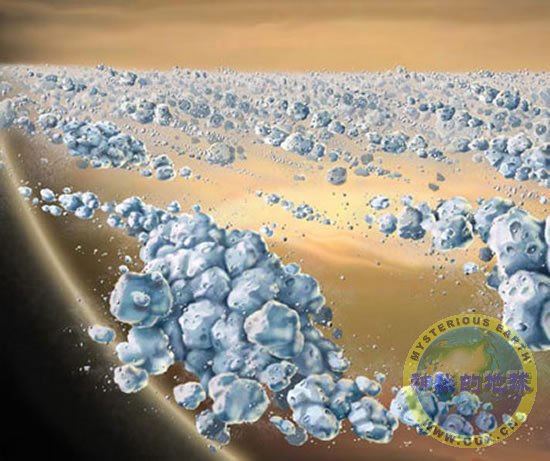Saturn's Rings as Old as Solar System, Study Says
An artist's illustration shows a close-up view of ring particles against the backdrop of the planet Saturn.
According to a new study, the debris, mostly made of ice, has been continuously clumping together and breaking up over the past four billion years. This "recycling" theory suggests a far older age for the rings that previously thought and hints that they may remain around Saturn for eons to come.
Image courtesy NASA/JPL/University of Colorado
Richard A. Lovett in San Francisco, California
for National Geographic News
December 13, 2007
Saturn's rings may be nearly as old as the solar system, a new study says, contradicting prior calculations that they clock in at only a few hundred million years.
That's because ring particles may have been repeatedly recycled during the previous four billion years, said study author Larry Esposito of the University of Colorado at Boulder—a finding that hints that the rings could last for many more eons.
Traditionally, experts have believed that Saturn's rings are the remnants of one or more small moons that broke up when they were hit by asteroids or comets.
According to the theory, additional collisions among the debris formed the fine ring particles we see today. But that couldn't have happened all that long ago, because otherwise continued meteorite bombardment would have hammered all of the particles to dust too fine to form visible rings.
Furthermore, the rings are full of features that appear to be quite young. (Related: "Moonlet Study Sheds Light on Origins of Saturn's Rings" [October 24, 2007].)
"Before, we thought that Saturn's rings had been recently created because we see many recently created features," Esposito said.
Too Young and Too Old
But scientists are obtaining ever-more-detailed observations of Saturn from NASA's orbiting Cassini spacecraft.
"The Cassini results are extending what we know about Saturn's rings in a particularly interesting way," Esposito said. "We see many even more youthful structures, not consistent with a single event that created the rings, say, in the age of the dinosaurs."
Rather, he said, "clumps," "propellers," "spokes," and other features come and go rapidly as tidal forces or collisions break them apart, while gravitational attraction causes new ones to form.
"We're seeing the rings as continuously recycling," he added. "Because of this, we can accommodate not only the dynamic, youthful processes that we see, but also the persistence of the rings. They're probably as old as the solar system and probably will last billions of years into the future."
There also appears to be about three times as much mass hiding in ring clumps than was previously suspected, Esposito said.
"Because the rings have more mass than was previously thought, they can still be bright and icy even after four billion years," he said yesterday at a meeting of the American Geophysical Union in San Francisco.
Rather than being a temporary feature that we just happen to live during the right time to see, he added, the rings might be like a long-standing city, with individual people coming and going while the overall structure remains.
Building Moonlets
Another recent study, led by planetary scientist Carolyn Porco of the Space Science Institute in Boulder, Colorado, may lend additional support to Esposito's theory.
Porco and her team found that it's possible for even fairly large moons—tens of miles across—to take shape around small, relatively dense ice kernels that have enough gravity to overcome the forces that would otherwise rip them apart.
But Porco isn't so sure that her work supports Esposito's, even though some of the ring features may well be recent.
"The idea that maybe the ring particles exchange contents with one another has been around a long time," she said.
But the problem with indefinite recycling of ring-building materials, she pointed out, is that not all of the dust will remain in the rings.
"Some of that [dust] gets charged and gets zipped out of the system [by magnetic forces]," she said. "Eventually all the particles are going to be eroded down to nothing."
But she noted that some of the existing moons within the Saturn system are big enough to create a lot of debris if hit by an asteroid.
"If you smashed up [the moonlet] Prometheus tomorrow, you'd get a ring," she said. "So of course these kinds of things might be going on."
Her theory of moonlet growth suggests that a mantle of softer, fluffy material surrounds the hard, dense "seed" at the center of the moon. The core could be a shard from the original collision, while the mantle would absorb the energy of incoming meteorites like a soft, thick bank of snow.
"That may help protect the core," she said. "Maybe the cores could have survived multiple break-ups and accreted [new] material."
But for billions of years? "I'm on the fence," she said. "Maybe the central, thickest part of the B ring [one of the brightest] might be very old, but I doubt that the other parts of the ring are ancient."












